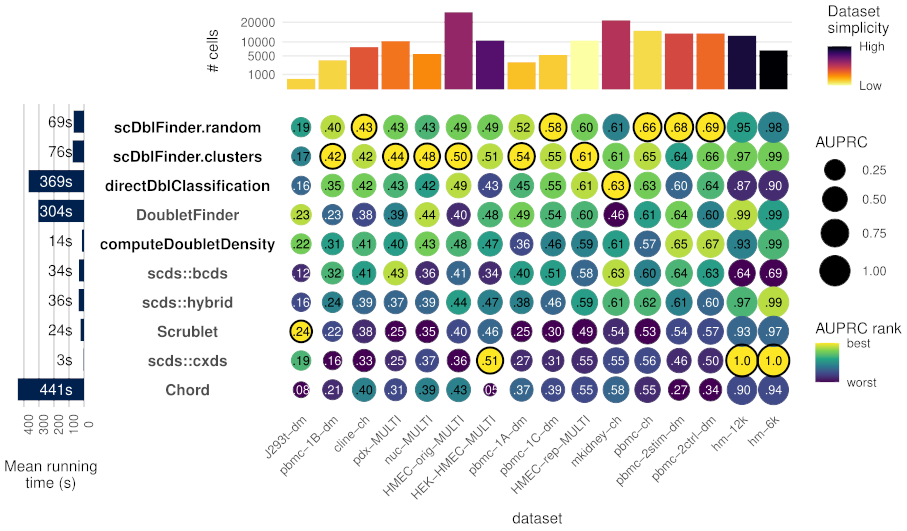The scDblFinder package gathers various methods for the detection and handling of doublets/multiplets in single-cell sequencing data (i.e. multiple cells captured within the same droplet or reaction volume), including the novel scDblFinder method.
The methods included here are complementary to doublets detection via cell hashes and SNPs in multiplexed samples: while hashing/genotypes can identify doublets formed by cells of the same type (homotypic doublets) from two samples, which are often nearly undistinguishable from real cells transcriptionally (and hence generally unidentifiable through the present package), it cannot identify doublets made by cells of the same sample, even if they are heterotypic (formed by different cell types). Instead, the methods presented here are primarily geared towards the identification of heterotypic doublets, which for most purposes are also the most critical ones.
For a brief overview of the methods, see the introductory vignette (vignette("introduction", package="scDblFinder")). For the detailed study including comparison with alternative methods, see the paper. Here, we will showcase doublet detection using the fast and comprehensive scDblFinder method.
You may install the pakage using:
BiocManager::install("scDblFinder")Or, to get the very latest version,
BiocManager::install("plger/scDblFinder")Given an object sce of class SingleCellExperiment (which does not contain any empty drops, but hasn't been further filtered), you can launch the doublet detection with:
library(scDblFinder)
sce <- scDblFinder(sce)This will add a number of columns to the colData of sce, the most important of which are:
sce$scDblFinder.score: the final doublet score (the higher the more likely that the cell is a doublet)sce$scDblFinder.class: the classification (doublet or singlet)
There are several additional columns containing further information (e.g. the most likely origin of the putative doublet), an overview of which is available in the vignette (vignette("scDblFinder")).
If you have multiple samples (understood as different cell captures, i.e. for multiplexed samples with cell hashes, rather use the batch), then it is preferable to provide scDblFinder with this information in order to take into consideration batch/sample-specific doublet rates. You can do this by simply providing a vector of the sample ids to the samples parameter of scDblFinder or, if these are stored in a column of colData, the name of the column. With default settings, the this will result in samples being processed separately, which appears to be faster, more robust to batch effects, and as accurate as training a single model (see the multiSampleMode argument for other options).
In such cases, you might also consider multithreading it using the BPPARAM parameter. For example:
library(BiocParallel)
sce <- scDblFinder(sce, samples="sample_id", BPPARAM=MulticoreParam(3))
table(sce$scDblFinder.class)scDblFinder has two main modes for generating artificial doublets: a random one (clusters=FALSE, now default) and a cluster-based one (clusters=TRUE or providing your own clusters - the approach from previous versions).
In practice, we observed that both approaches perform well (and better than alternatives).
We suggest using the cluster-based approach when the datasets are segregated into clear clusters, and the random one for the rest (e.g. developmental trajectories).
The expected proportion of doublets has little impact on the score, but a very strong impact on where the threshold will be placed (the thresholding procedure simultaneously minimizes classification error and departure from the expected doublet rate). It is specified through the dbr parameter and the dbr.sd parameter (the latter specifies the standard deviation of dbr, i.e. the uncertainty in the expected doublet rate). For 10x data, the more cells you capture the higher the chance of creating a doublet, and Chromium documentation indicates a doublet rate of roughly 1% per 1000 cells captures (so with 5000 cells, (0.01*5)*5000 = 250 doublets), and the default expected doublet rate will be set to this value (with a default standard deviation of 0.015). Note however that different protocols may create considerably more doublets, and that this should be updated accordingly. If you are unsure about the doublet rate, set dbr.sd=1 and the thresholding will be entirely based on the misclassification rates.
The scDblFinder method can be to single-cell ATACseq (on peak-level counts), however when doing so we recommend using the aggregateFeatures=TRUE parameter (see vignette).
In addition, the package includes a reimplementation of the Amulet method from Thibodeau et al. (2021).
For more detail, please see vignette("scDblFinder").
scDblFinder was independently evaluated by Nan Miles Xi and Jingyi Jessica Li in the addendum to their excellent benchmark, where they write that "scDblFinder achieves the highest mean AUPRC and AUROC values, and it is also the top method in terms of the precision, recall, and TNR under the 10% identification rate."
The figure below compares some of the methods implemented in this package (in bold) with alternative methods (including the top alternative, DoubletFinder):
 Figure1: Accuracy (area under the precision and recall curve) of doublet identification using alternative methods across 16 benchmark datasets from Xi and Li (2020). The colour of the dots indicates the relative ranking for the dataset, while the size and numbers indicate the actual area under the (PR) curve. For each dataset, the top method is circled in black. Methods with names in black are provided in the
Figure1: Accuracy (area under the precision and recall curve) of doublet identification using alternative methods across 16 benchmark datasets from Xi and Li (2020). The colour of the dots indicates the relative ranking for the dataset, while the size and numbers indicate the actual area under the (PR) curve. For each dataset, the top method is circled in black. Methods with names in black are provided in the scDblFinder package. Running times are indicated on the left. On top the number of cells in each dataset is shown, and colored by the proportion of variance explained by the first two components (relative to that explained by the first 100), as a rough guide to dataset simplicity.
Rather a python person? You can have a look at vaeda, another doublet finding method which appears to have performances very close to those of scDblFinder.